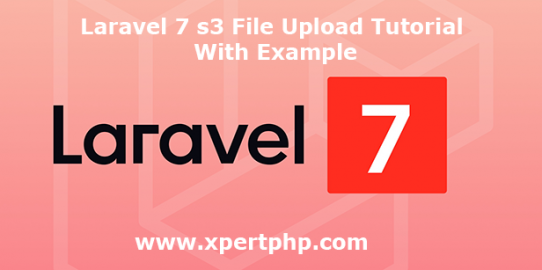Today, We will explain to you Laravel 7 s3 File Upload Tutorial With Example. here we are using the amazon s3 package for file upload. so here we step by step explain to you how to upload images in the s3. you can also upload files in s3 using laravel but in this article, we will upload the images in the s3 using laravel.
So you can follow the below steps for upload image in s3 using laravel 7.
Overview
Step 1: Install Laravel 7
Step 2: Install S3 Package
Step 3: Setup amazon Bucket
Step 4: Setup amazon s3 Cloud Storage Credentials
Step 5: Create Controller
Step 6: Create Route
Step 7: Create Blade Files
Step 8: Run Our Laravel Application
Laravel 7 s3 File Upload Tutorial With Example
Step 1: Install Laravel 7
We are going to install laravel 7, so first open the command prompt or terminal and go to xampp htdocs folder directory using the command prompt. after then run the below command.
1 | composer create-project --prefer-dist laravel/laravel laravel7_s3_image |
Step 2: Install S3 Package
Now, We will install an amazon s3 package using the below command.
1 | composer require league/flysystem-aws-s3-v3 |
Step 3: Setup amazon Bucket
here in this step, you have to login or sign up on your AWS console https://console.aws.amazon.com. after then you can create a bucket. so you can follow the URL for Create an Amazon S3 Bucket.
Step 4: Setup Amazon S3 Cloud Storage Credentials
After the complete installation of the amazon s3 package. we have to API credentials configuration. now we will open the .env file and add API credentials. See below changes in a .env file.
1 2 3 4 | AWS_ACCESS_KEY_ID=Access Key Id AWS_SECRET_ACCESS_KEY=Secret Access Key AWS_DEFAULT_REGION=Bucket Region AWS_BUCKET=Bucket Name |
Step 5: Create Controller
Here below command help to create the controller.
1 | php artisan make:controller ImageUploadController |
app/Http/ImageUpload.php
1 2 3 4 5 6 7 8 9 10 11 12 13 14 15 16 17 18 19 20 21 22 23 24 25 26 27 28 29 30 31 32 33 34 35 36 37 38 39 | <?php namespace App\Http\Controllers; use Illuminate\Http\Request; class ImageuploadController extends Controller { /** * Display a listing of the resource. * * @return \Illuminate\Http\Response */ public function image_upload() { return view('image_upload'); } /** * Display a listing of the resource. * * @return \Illuminate\Http\Response */ public function upload_post_image(Request $request) { $request->validate([ 'image' => 'required|image|mimes:jpeg,png,jpg,gif,svg|max:2048', ]); if($request->hasfile('image')) { $file = $request->file('image'); $imageName=time().$file->getClientOriginalName(); $filePath = 'images/' . $imageName; Storage::disk('s3')->put($filePath, file_get_contents($file)); return back()->with('success','You have successfully upload image.'); } } } ?> |
Step 6: Create Route
Add the following route code in the “routes/web.php” file.
1 2 3 4 5 6 7 8 9 10 11 12 13 14 15 | <?php /* |-------------------------------------------------------------------------- | Web Routes |-------------------------------------------------------------------------- | | Here is where you can register web routes for your application. These | routes are loaded by the RouteServiceProvider within a group which | contains the "web" middleware group. Now create something great! | */ Route::get('image-upload', 'ImageuploadController@image_upload')->name('image.upload'); Route::post('image-upload', 'ImageuploadController@upload_post_image')->name('upload.post.image'); ?> |
Step 7: Create Blade Files
So finally, first we will open the image-upload.blade.php file and then paste the following code.
resources/views/image-upload.blade.php
1 2 3 4 5 6 7 8 9 10 11 12 13 14 15 16 17 18 19 20 21 22 23 24 25 26 27 28 29 30 31 32 33 34 35 36 37 38 39 40 41 42 43 44 45 46 47 48 | <!DOCTYPE html> <html lang="en"> <head> <title>Laravel 7 S3 Image Upload tutorial example - XpertPhp</title> <meta charset="utf-8"> <meta name="viewport" content="width=device-width, initial-scale=1"> <link rel="stylesheet" href="https://maxcdn.bootstrapcdn.com/bootstrap/3.4.1/css/bootstrap.min.css"> <script src="https://ajax.googleapis.com/ajax/libs/jquery/3.4.1/jquery.min.js"></script> <script src="https://maxcdn.bootstrapcdn.com/bootstrap/3.4.1/js/bootstrap.min.js"></script> </head> <body> <div class="container"> <div class="row"> <div class="col-lg-12"> @if ($message = Session::get('success')) <div class="alert alert-success alert-block"> <button type="button" class="close" data-dismiss="alert">×</button> <strong>{{ $message }}</strong> </div> @endif @if (count($errors) > 0) <div class="alert alert-danger"> <strong>Whoops!</strong> There were some problems with your input. <ul> @foreach ($errors->all() as $error) <li>{{ $error }}</li> @endforeach </ul> </div> @endif </div> </div> <form action="{{ route('upload.post.image') }}" method="POST" enctype="multipart/form-data"> @csrf <div class="row"> <div class="col-md-6"> <input type="file" name="image" class="form-control"> </div> <div class="col-md-6"> <button type="submit" class="btn btn-success">Upload</button> </div> </div> </form> </div> </body> </html> |
Step 8: Run Our Laravel Application
We can start the server and run this example using the below command.
1 | php artisan serve |
Now we will run our example using the below Url in the browser.
1 | http://127.0.0.1:8000/image-upload |
